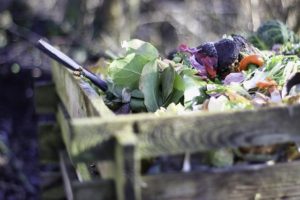Learn about the best ways to compost food scraps in a small composter in fall and winter.
Listen to Podcast:
 Although Vermont’s new law on banning food scraps in landfills begins to take effect this fall, homeowners will still have a number of years to get their systems in place. But there’s no reason to wait until the government tells you to do it. Food scrap composting is easy and produces great compost. Here’s some tips to get started.
Although Vermont’s new law on banning food scraps in landfills begins to take effect this fall, homeowners will still have a number of years to get their systems in place. But there’s no reason to wait until the government tells you to do it. Food scrap composting is easy and produces great compost. Here’s some tips to get started.
Probably the easiest way to compost food scraps is to get a commercial composter. Plastic boxes are fine, but if you have rodent problems or want to make compost quickly, consider using a composting barrel or tumbler. Composters allow you to add food scraps (except bones, meats, fatty food, and fish) daily. But with any system, there’s a best way to do it.
Good compost is made from a mix of carbon and nitrogen materials, air and moisture. Most of the food waste we create in our kitchens is high in moisture and nitrogen. While it break downs quickly, it also can be smelly and fly ridden. To avoid this problem, add a thin layer of a high carbon material such as sawdust, peat moss, or shredded newspaper every time you add food scraps. I like using coir. Coir is ground up coconut husks and its fibers are hydrophilic. This means they can absorb moisture easily and drain it quickly.
Once your box or barrel is filled with these layers, mix them together and let it sit all winter. Start filling another composter with food waste and add to it right through the winter. By next summer your first batch should be usable.


